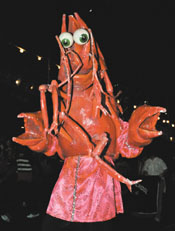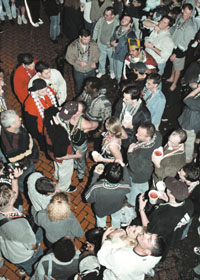What do justice, faith and power have in common with lewd behavior, drunkenness and gluttony? Only the biggest celebration of the year for those who live in and visit the Crescent City during the period of time just before Christian Lent. Historians say the celebration of Mardi Gras, or Fat Tuesday, originated during the second century in Rome to honor Bacchus, the god of wine and fertility, and Venus, the goddess of love and beauty. The celebration has continued as a last opportunity for Christians to revel in pursuit of pleasure before the fasting period from Ash Wednesday to Easter. Its history in New Orleans began in 1699, when the French explorer Pierre LeMoyne, Sieur d'Iberville and his men camped south of the city on March 3, Mardi Gras Day. d'Iberville named the campsite Pointe du Mardi Gras, and soon after the French began celebrating in the area. The carnival season officially begins on Jan. 6, the twelfth day after Christmas, with the ball of the Twelfth Night Revelers. The actual day of Mardi Gras occurs on a different date each year, as dictated by the date of Easter on the Christian calendar. The official colors of Mardi Gras, which represent justice, faith and power, are purple, green and gold, respectively. These colors were chosen by the King of Carnival in 1872. Mardi Gras features lavish parades sponsored by krewes, masking and parading clubs for which New Orleans is famous.
The king of the Krewe of Rex is always the King of Carnival. Some krewes such as Barkus, which benefits local animal shelters and national humane societies, are relatively new. In this particular case, the krewe was founded in 1993 and limited its membership to dogs. The headquarters of the krewe is in the area near the "flea market" and the members of the krewe warn that "Cats, while welcome, will not be provided with security." And, "No dogs may be 'in season' and owners are responsible for their own dog's scoop." The parades this year will take place from Feb. 25 to March 7, Mardi Gras Day. Many students take off for the weekend to experience the insanity of this huge celebration, collect tons of beads and taste rich king cakes. Pete Hoffman, a junior e-business and finance major and captain of the men's lacrosse team, said that the celebration is like nothing he's ever experienced before. "It's the most fun time I've ever had - period," he said. "It's just wild, a non-stop party. I mean everything's going. Bourbon Street's insane, it's wall to wall people." Through their association with the lacrosse tournament, the men were able to get on a balcony, which Hoffman said is the prime location to enjoy the events. "If you're down on the street level, you don't really see anything. But if you're above, everybody looks up at you and you're looking at everybody. And you're yelling at people, and people are yelling up at you." There are some hot spots that are worth visiting, Hoffman said. Pat O'Brien's, which is on the corner of Bourbon and St. Peter streets, is a great spot to kick back and enjoy the celebration, he said. It's kitty-corner from the Cat's Meow, where people who don't have the money or connections to get a balcony have a chance to experience Mardi Gras for a limited time from the balcony of the bar. Although the celebration is notorious for its wild side, there are areas of the city that are very safe and tame. College students may be more attracted to the party scene on Bourbon Street, but many families bring their children and grandparents to experience the floats, catch beads and other throws and view the elaborate costumes prevalent on Mardi Gras Day. The rowdiness of the Mardi Gras celebration has been a characteristic of the event since its beginnings in New Orleans. Historians say that Mardi Gras celebrations have featured masked balls and wild street parades since the early 1700s. As a result of the outrageous behavior of the participants, the celebrations were forbidden in the early 1800s, but the law was ignored and the celebrations continued. In 1817, masks were declared illegal, but they were legalized again in 1826 because the law wasn't enforced. Since the celebration lasts so long, the parties tend to get rowdier the closer they occur to Mardi Gras Day.
The lacrosse team visited New Orleans during the third weekend of Mardi Gras, and Hoffman said he's glad that they went then instead of the following weekend. "It is the best balance of having a fabulous, great, exciting, incredible time yet, you know, also not being to the point where it is dangerous," he said. Visitors to the celebration need to remember to stay within certain areas on Bourbon Street and to avoid pickpockets and other kinds of trouble, Hoffman said. "There's just places you don't go; you don't wander off the beaten path because bad things could happen," he said. Tracy Glasheen, a senior accounting and finance major and second captain of the women's lacrosse team, said though she heard rumors of organized crime and people being stalked in the bad areas off Bourbon Street, she wasn't scared. "I didn't see any conflicts or fights; we were in a huge group so we felt very safe," she said. She advised people to go in a big group and stay together because it's very easy to get lost and end up on the back streets. Cameron Ressetar, a junior marketing and finance double major and lacrosse team member, said the best part of going to Mardi Gras was going with the team. He stressed the importance of going with a big group of people in which everyone gets along. He advised visitors to watch the people around them because Bourbon Street is known for petty thieves. "Other than that, just kind of lay back, relax and go with the flow," he said. "Things are different down there, the atmosphere is anything goes, just deal with it. Being in the confusion is kind of a different experience. I've never experienced anything that chaotic or wild in my life."
Carey Hix
|
| The TCU Daily Skiff © 1998, 1999 Credits |
 Some of the krewes have been around for a long time, such
as Comus, which was founded in 1856. Comus took its name from the Greek
komos, meaning revelers.
Some of the krewes have been around for a long time, such
as Comus, which was founded in 1856. Comus took its name from the Greek
komos, meaning revelers. "The last weekend before Fat Tuesday is the craziest,"
Hoffman said. "It's the most insane weekend almost to the point of
being dangerous."
"The last weekend before Fat Tuesday is the craziest,"
Hoffman said. "It's the most insane weekend almost to the point of
being dangerous."